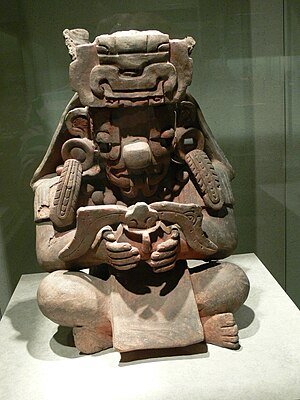
Cocijo[pronunciation?] (occasionally spelt Cociyo, otherwise known as Guziu in the Zapotec language) is a lightning deity of the pre-Columbian Zapotec civilization of southern Mexico. He has attributes characteristic of similar Mesoamerican deities associated with rain, thunder and lightning, such as Tlaloc of central Mexico, and Chaac (or Chaak) of the Maya civilization.[1] In the Zapotec language, the word cocijo means "lightning", as well as referring to the deity.[1]
Cocijo was the most important deity among the pre-Columbian Zapotecs because of his association with rainfall.[2][3] He is commonly represented on ceramics from the Zapotec area, from the Middle Preclassic right through to the Terminal Classic.[1] Cocijo was said to be the great lightning god and creator of the world.[4] In Zapotec myth, he made the sun, moon, stars, seasons, land, mountains, rivers, plants and animals, and day and night by exhaling and creating everything from his breath.[4]
- ^ a b c Miller & Taube 1993, 2003, p.64.
- ^ Avila Aldapa 2002, p.97.
- ^ Birmingham Museum of Art (2010). Birmingham Museum of Art: Guide to the Collection. London, UK: GILES. p. 82. ISBN 978-1-904832-77-5. Archived from the original on 2011-09-10. Retrieved 2011-06-30.
- ^ a b Read & González 2000, p.248.